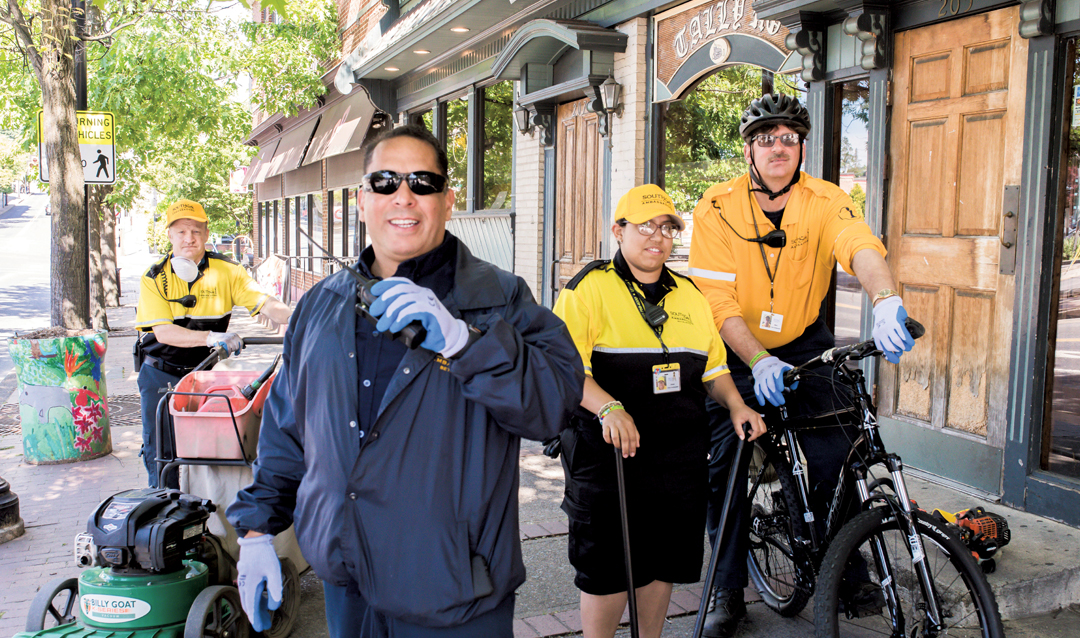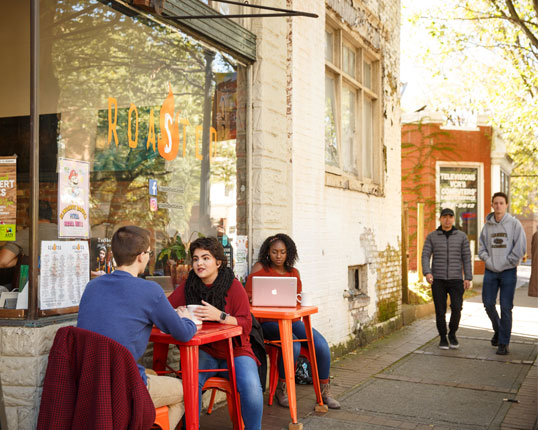On a Wednesday morning in April, Hector Lopez, operations manager for the SouthSide Ambassadors, is standing on Third Street in Bethlehem, near the Lit Coffee Roastery & Bakeshop. It’s 9 a.m., but already members of his seven-person crew have been on the streets for an “impact clean,” picking up discarded pizza boxes, cups, anything big, anything obvious.
“So, when that morning traffic comes through, nobody is seeing that,” says Lopez. “Our hopes are, when people come through, they are seeing a clean downtown and might think, ‘Hey, this is nice. I might come down here for dinner tonight.’ So that’s important.”

Hector Lopez and his team of SouthSide Ambassadors have played a crucial role in changing the perceptions of South Bethlehem.
Seven days a week in the South Side’s core commercial district, the Ambassadors are on the job from 7 a.m. until 11:30 p.m. Morning details focus on sweeping the sidewalks in an 18-block radius, pulling weeds from tree beds, picking up leaves, sprucing up. Later in the day, the Ambassadors focus on safety issues.
The Ambassadors also provide plenty of hospitality—helping visitors with parking meters, directions and restaurant locations.
Since the program was created in 2014 in partnership with Lehigh and the Bethlehem Economic Development Corp. (BEDCO), the Ambassadors have expanded their footprint on the South Side with support from the Community Action Development Corp. of Bethlehem. Praise for the program is widespread, but initially, there was skepticism that the Ambassadors could make a difference.
“When I first started, I made it my point to come in to visit these business owners and tell them what we were doing. ... I was met with, ‘Good luck.’ Because, listen, it was pretty rough down here. It was dirty. Street lights were out. Curb lines were just covered with garbage, out almost 16, 18 inches from the curb. That doesn’t seem like a big deal when you’re in it every day, but when it’s gone, what a difference it made.
“Things have changed considerably,” he says. “ Now, [business owners] say, ‘We don’t want you to go, we love that you are here.’... It’s pretty cool.”
Adrienne McNeil, assistant vice president for community and regional affairs at Lehigh, says the dirty streets fed people’s negative perceptions of the South Side. “Now we are starting to see a change in that perception just because the sidewalks are clean,” says McNeil, who also sits on the SouthSide Arts District’s advisory board and its economic vitality committee.
As an Ambassador, Lopez also saw opportunity in reaching out to first-year Lehigh students—to make them feel welcome in Bethlehem and to foster an appreciation for the work being done. He now leads tours of first-years through the South Side at the start of each academic year.
“I just wanted to let them know who we were,” Lopez says. “In the event that they are downtown, and they don’t know where they are going or they feel confused or they feel unsafe, or whatever, that if they saw us in our uniform they knew who we were, and we could get them where they need to go or give them whatever assistance they need in anything.”

The Ambassadors keep the streets clean in the South Side’s core commercial district, which includes the area outside the Roasted eatery.
McNeil works with Lehigh’s Office of First-Year Experience on Faux Friday, when first-years eat at South Side restaurants as part of the effort to get them to check out the core business district. Last fall, she says, about 1,100 students participated.
Then, on the first Friday in October, McNeil leads one of Lehigh’s 5X10 (five programs over 10 weeks) series. Participating students meet her at Farrington Square, then they walk together to the Color Me Mine pottery place on Third Street, where they can make plates, bowls and mugs imprinted with the Lehigh logo. “Part of that is just showing them that Third and Fourth streets are close,” she says. “It’s a fun thing for them.”
McNeil hopes that the activities send a message to Lehigh students: That South Bethlehem is clean and vibrant and a safe place to explore.
Lehigh President Simon is among those who point to the Ambassadors program, which Lehigh financially supports, as a significant part of the Lehigh-Bethlehem partnership. “In a lot of people’s minds, it’s not clear who they work for, whether they work for the City of Bethlehem or whether they work for Lehigh University,” Simon says. “And to me, that is a successful way to view it. They are out there to make the South Side better.”


